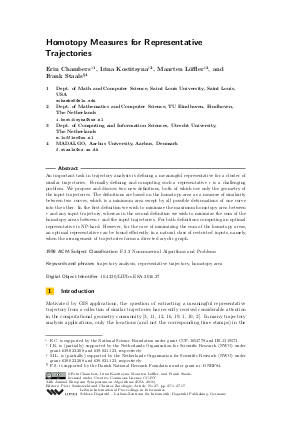Homotopy Measures for Representative Trajectories
Authors Erin Chambers, Irina Kostitsyna, Maarten Löffler, Frank Staals
-
Part of:
Volume:
24th Annual European Symposium on Algorithms (ESA 2016)
Part of: Series: Leibniz International Proceedings in Informatics (LIPIcs)
Part of: Conference: European Symposium on Algorithms (ESA) - License:
 Creative Commons Attribution 3.0 Unported license
Creative Commons Attribution 3.0 Unported license
- Publication Date: 2016-08-18
File

PDF
LIPIcs.ESA.2016.27.pdf
- Filesize: 1 MB
- 17 pages
Document Identifiers
Subject Classification
Keywords
- trajectory analysis
- representative trajectory
- homotopy area
Metrics
- Access Statistics
-
Total Accesses (updated on a weekly basis)
0PDF Downloads0Metadata Views
Abstract
An important task in trajectory analysis is defining a meaningful representative for a cluster of similar trajectories. Formally defining and computing such a representative r is a challenging problem. We propose and discuss two new definitions, both of which use only the geometry of the input trajectories. The definitions are based on the homotopy area as a measure of similarity between two curves, which is a minimum area swept by all possible deformations of one curve into the other. In the first definition we wish to minimize the maximum homotopy area between r and any input trajectory, whereas in the second definition we wish to minimize the sum of the homotopy areas between r and the input trajectories. For both definitions computing an optimal representative is NP-hard. However, for the case of minimizing the sum of the homotopy areas, an optimal representative can be found efficiently in a natural class of restricted inputs, namely, when the arrangement of trajectories forms a directed acyclic graph.
Cite As Get BibTex
Erin Chambers, Irina Kostitsyna, Maarten Löffler, and Frank Staals. Homotopy Measures for Representative Trajectories. In 24th Annual European Symposium on Algorithms (ESA 2016). Leibniz International Proceedings in Informatics (LIPIcs), Volume 57, pp. 27:1-27:17, Schloss Dagstuhl – Leibniz-Zentrum für Informatik (2016)
https://doi.org/10.4230/LIPIcs.ESA.2016.27
BibTex
@InProceedings{chambers_et_al:LIPIcs.ESA.2016.27,
author = {Chambers, Erin and Kostitsyna, Irina and L\"{o}ffler, Maarten and Staals, Frank},
title = {{Homotopy Measures for Representative Trajectories}},
booktitle = {24th Annual European Symposium on Algorithms (ESA 2016)},
pages = {27:1--27:17},
series = {Leibniz International Proceedings in Informatics (LIPIcs)},
ISBN = {978-3-95977-015-6},
ISSN = {1868-8969},
year = {2016},
volume = {57},
editor = {Sankowski, Piotr and Zaroliagis, Christos},
publisher = {Schloss Dagstuhl -- Leibniz-Zentrum f{\"u}r Informatik},
address = {Dagstuhl, Germany},
URL = {https://drops.dagstuhl.de/entities/document/10.4230/LIPIcs.ESA.2016.27},
URN = {urn:nbn:de:0030-drops-63783},
doi = {10.4230/LIPIcs.ESA.2016.27},
annote = {Keywords: trajectory analysis, representative trajectory, homotopy area}
}
Author Details
References
-
Pankaj K. Agarwal, Mark de Berg, Jie Gao, Leonidas J. Guibas, and Sariel Har-Peled. Staying in the middle: Exact and approximate medians in R¹ and R² for moving points. In CCCG, pages 43-46, 2005.

-
Riddhipratim Basu, BhaswarB. Bhattacharya, and Tanmoy Talukdar. The projection median of a set of points in R^d. Discrete &Computational Geometry, 47(2):329-346, 2012.

- Kevin Buchin, Maike Buchin, Joachim Gudmundsson, Maarten Löffler, and Jun Luo. Detecting commuting patterns by clustering subtrajectories. IJCGA, 21(03):253-282, 2011. URL: http://dx.doi.org/10.1142/S0218195911003652.
- Kevin Buchin, Maike Buchin, Marc Kreveld, Maarten Löffler, RodrigoI. Silveira, Carola Wenk, and Lionov Wiratma. Median trajectories. Algorithmica, 66(3):595-614, 2013. URL: http://dx.doi.org/10.1007/s00453-012-9654-2.
-
Erin W. Chambers and David Letscher. On the height of a homotopy. In CCCG, pages 103-106, 2009.

- Erin Wolf Chambers and Mikael Vejdemo-Johansson. Computing minimum area homologies. Computer Graphics Forum, 2014. URL: http://dx.doi.org/10.1111/cgf.12514.
- Erin Wolf Chambers and Yusu Wang. Measuring similarity between curves on 2-manifolds via homotopy area. In Proc. 29th Ann. Symp. on CG, pages 425-434. ACM, 2013. URL: http://dx.doi.org/10.1145/2462356.2462375.
- Erin Wolf Chambers, Éric Colin de Verdière, Jeff Erickson, Sylvain Lazard, Francis Lazarus, and Shripad Thite. Homotopic fréchet distance between curves or, walking your dog in the woods in polynomial time. CG, 43(3):295-311, 2010. URL: http://dx.doi.org/10.1016/j.comgeo.2009.02.008.
-
Timothy M Chan. On levels in arrangements of curves, iii: further improvements. In Proc. of the 24th annual symposium on Computational geometry, pages 85-93. ACM, 2008.

-
Stephane Durocher and David Kirkpatrick. The projection median of a set of points. CG, 42(5):364-375, 2009.

-
S. Gaffney, A. Robertson, P. Smyth, S. Camargo, and M. Ghil. Probabilistic clustering of extratropical cyclones using regression mixture models. Climate Dynamics, 29(4):423-440, 2007.

-
S. Gaffney and P. Smyth. Trajectory clustering with mixtures of regression models. In Proc. 5th ACM SIGKDD Int. Conf. Knowledge Discovery and Data Mining, pages 63-72, 1999.

- Sariel Har-Peled, Amir Nayyeri, Mohammad Salavatipour, and Anastasios Sidiropoulos. How to walk your dog in the mountains with no magic leash. In Proc. 28th Ann. Symp. on CG, pages 121-130. ACM, 2012. URL: http://dx.doi.org/10.1145/2261250.2261269.
- Allen Hatcher. Algebraic Topology. Cambridge University Press, 2001. URL: http://www.math.cornell.edu/~hatcher/.
- Donald E. Knuth and Arvind Raghunathan. The problem of compatible representatives. SIAM Journal on Discrete Mathematics, 5(3):422-427, 1992. URL: http://dx.doi.org/10.1137/0405033.
-
J.G. Lee, J. Han, and K.Y. Whang. Trajectory clustering: a partition-and-group framework. In Proc. ACM SIGMOD Int. Conf. on Management of Data, pages 593-604, 2007.

- David Lichtenstein. Planar formulae and their uses. SIAM J. Comput., 11(2):329-343, 1982. URL: http://dx.doi.org/10.1137/0211025.
-
James R. Munkres. Topology. Prentice-Hall, 2nd edition, 2000.

-
M. Vlachos, D. Gunopulos, and G. Kollios. Discovering similar multidimensional trajectories. In Proc. 18th Int. Conf. Data Engin., pages 673-684, 2002.

